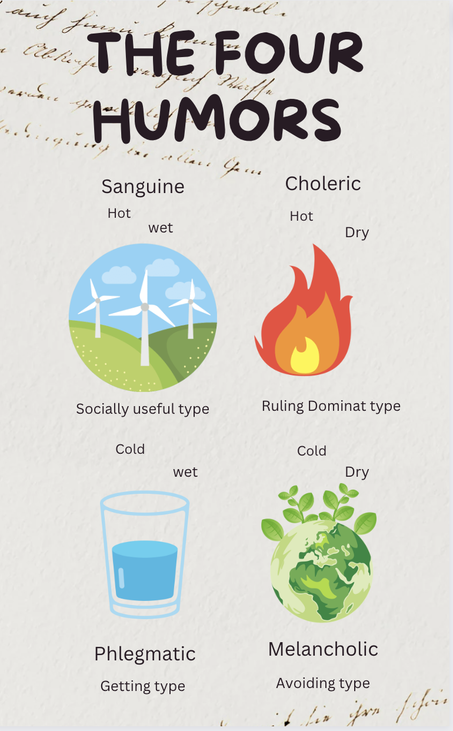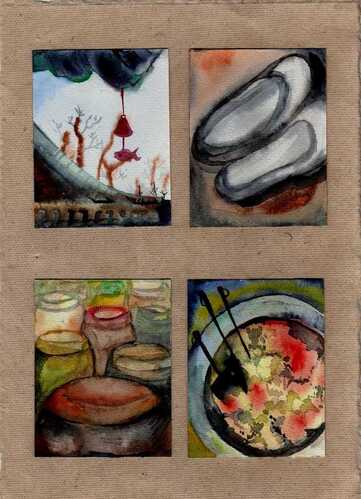Four temperamentsAt least until the 1700s, European medicine supported the theory of the four humors, which underpinned ideas about the inner workings of the body. According to humorism, four bodily fluids—blood, yellow bile, black bile, and phlegm—determine a person's temperament, and imbalances lead to certain diseases depending on which bodily fluid is in excess or deficit. Bodily fluids were linked to celestial bodies, seasons, body parts, and stages of life. The four humors were part of Shakespearean cosmology inherited from the ancient Greek philosophers Aristotle, Hippocrates, and Galen. It is organized around four elements: earth, water, air and fire. the four qualities of cold, hot, wet and dry; And the four humors, these physical properties, determined the behavior of all creatures, including the human body. The interaction of the four humors in the human body accounted for differences in age, gender, emotion, and disposition. The influence of bodily fluids changed according to the season, time of day, and human lifespan. Heat stimulates action, cold inhibits it. The connection between the four humors theory and personality temperament can be explained in a simple way. blood / sanguine / highly talkative, enthusiastic, active, social phlegm / phlegmatic / relaxed, peaceful, quiet, easy-going. yellow bile / choleric / extroverted, independent, decisive, goal-oriented black bile / melancholic / analytical, detail-oriented, thoughtful, reserved So, the meaning of the four adjectives from here has been settled in modern English like this. sanguine cheerful, optimistic phlegmatic calm, calm choleric, irritable melancholic, gloomy In the East, it is an idea that tried to explain the change of all things in the universe by compressing it into five energies: wood, fire, earth, metal, and water.
It is often compared to Western novels of the four elements. There are many elements in the world with two opposite qualities. Woman and man, day and night, life and death, joy and sorrow, plus and minus, cold and hot, brain and heart. And as the day and night always change when looking at the world, these two attributes, 'yin and yang', are considered to have a cyclical nature. The idea of oriental philosophy based on Yin-Yang and the Five Elements begins here. Yin and Yang are derived from Taegeuk, and fire, water, neck, gold, and earth, which are furthermore called the five elements, are derived. will be. The five elements are considered to be derived from yin and yang. At this time, extremely positive ones are regarded as 'hwa', extremely negative ones as 'su', positive or negative ones as 'throat', negative or positive ones as 'gold', and neutral ones. It is seen as 'Sat'. Taegeuk is the source of the world, and Yin-Yang and the five elements come from it, so 'the principle of all things in the world' and 'the principle of the five elements of yin and yang' are the same. The main characteristics of the five elements are the cycle of life and contradiction. As a result of observation of nature, it can be seen that many things rotate and rotate, and sometimes repel each other. If you put it as the representative five elements of the Five Elements, trees grow through water, fire catches up through trees, and what remains after burning Ash returns to the ground, metal comes out of the earth, and you can see the cycle of metal holding water. It is a key element of the idea of the Five Elements that this creation, circulation, killing, friction, and contradiction are applied to the principle of all things in the world, not simply that trees drink water. This can be seen as 'a way of seeing the world', as is the case with philosophy, but it can also be seen as a modern mainstream philosophy, and its limitations are revealed when contrasted with 'science', which is the core driving force of human technological development.
0 Comments
Leave a Reply. |
Myungja Anna KohArtist Categories
All
Archives
July 2024
|
Proudly powered by Weebly



 RSS Feed
RSS Feed